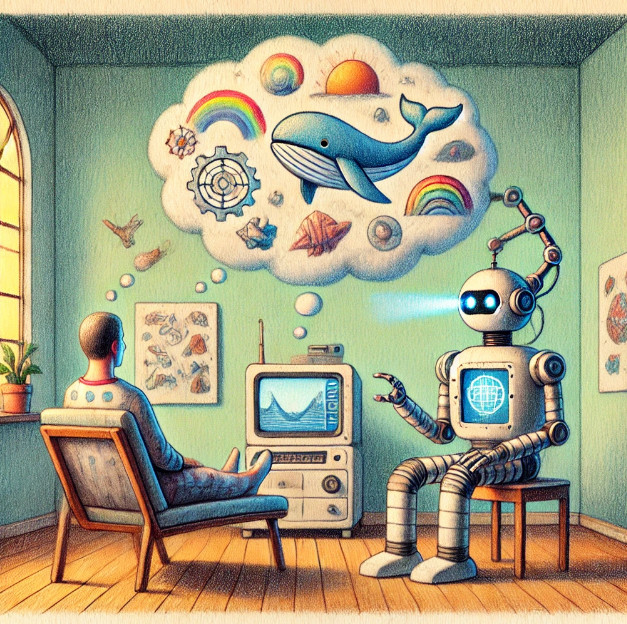Dream-Catching AI: The Netflix Series in Your Head?
 Manasa V
Manasa V
Ever woken up from a dream and thought, “Wow… that was Oscar-worthy. Too bad I can’t remember half of it now.”
Well, AI might just change that and no, it’s not going to crawl into your head with popcorn.
A technology that turns your brainwave patterns into dream-like images. Yes, you read that right. We’re talking about AI-powered “dream printers” that can take the mysterious thoughts in your head at night and bring it to life visually.
Wait… AI Can See My Dreams?!
Not exactly “see” like a mind-reading person (phew), but researchers are training AI to interpret brainwave patterns and turn them into images or short clips. Think of it like giving your subconscious a movie director and your thoughts are the script.
This magic works by:
Reading brain activity: using fancy tech like fMRI or EEG to map your brain signals.
Training AI models: feeding them both your brainwave data and what you were looking at/thinking about.
Reconstructing visuals: the AI tries to “paint” what it thinks you saw or imagined.
The result? A trippy, slightly fuzzy but eerily accurate video of what was playing in your head.
How Does It Even Work?
Let’s break it down without frying your brain:
Brainwave Recording
To visualize dreams, we first need to capture what’s going on inside your brain while you sleep or imagine something. This is done with:
EEG (Electroencephalography): Portable headbands with electrodes measure electrical signals from the scalp. They are comfortable but have lower resolution.
fMRI (Functional Magnetic Resonance Imaging): Uses magnetic fields to track blood flow in the brain. Higher spatial accuracy, but the machine looks like a giant space pod.
MEG (Magnetoencephalography): Captures magnetic fields from brain activity with high temporal accuracy, but it’s still mostly lab equipment.
Each method comes with a trade-off between clarity, comfort, and cost.
Pattern Translation
Once brain activity is recorded, AI models need to figure out what those patterns mean. This is usually done with training data where the person is shown specific images while their brain activity is recorded.For example:
You look at a cat picture → your brain produces a distinct pattern.
You look at the color blue → different pattern.
By pairing brain data with actual images, AI learns to map signals to semantic concepts.
Dream Rendering
After decoding the concepts, the AI uses generative models like:GANs (Generative Adversarial Networks): Great for producing realistic images from noise.
CLIP-based Models: CLIP (Contrastive Language–Image Pretraining) is an AI model created by OpenAI. It is like a translator between words and pictures. It’s trained on millions of images and their captions, so it understands how text and visuals connect. Map brain signals into a shared “language” with image/text embeddings so that what you “think” aligns with what AI can draw.
It’s like the AI is sitting in your head with a paintbrush saying, “Alright, let’s draw this!”

Mind-Reading Dreams: Cool or Creepy?
Dream-reading tech is a double-edged pillow. On the cool side, artists could spin up surreal worlds without lifting a pen, therapists might help people wander through their subconscious like never before, and researchers could unlock entirely new ways of understanding how our minds build strange and vivid stories while we sleep. But here’s the creepy bit: do you really want your brain broadcasting your 3 AM zombie apocalypse dreams for the world to see?
Here as some fun facts for you!💡
Your longest dreams happen in the morning right before you wake up, during the final REM cycles.
The Pizza Effect: In experiments, AI has successfully recreated images like pizza just from brain scans.
Dreams are like fingerprints: your brainwave patterns are unique, meaning the AI has to be trained on you to work well.
The Fun Angle : Dreamflix
Imagine a streaming platform where every “movie” is just someone’s dream turned into a visual story. You could literally binge-watch your own subconscious.
Episode titles could be:
Season 1, Episode 1: “Lost in the IKEA That Never Ends”
Season 2, Episode 4: “Flying a Hot Air Balloon Made of Marshmallows”
Season 3, Episode 7: "The Great Taco Chase"
Are We There Yet?
We’re in the very early stages. Some experiments have managed to reconstruct blurry, dream-like visuals from brain scans, but nothing Hollywood-ready yet. Still, progress in AI + neuroscience is moving fast so don’t be surprised if in a few years, your dreams are stored in the cloud like Netflix episodes you can rewatch.
Real-World “Dream Tech” Experiments You Won’t Believe
Japan’s “Dream Decoding” Lab: At ATR Computational Neuroscience Labs, scientists basically played “Guess My Dream” with brain scans. Using fMRI + machine learning, they could predict what you were dreaming about with around 60% accuracy. That’s like Netflix guessing your next binge while you’re asleep.
Europe’s Lucid Dream Zapping: Researchers used mild brain stimulation (tDCS) to spark lucid dreams meaning you could control parts of your dream story. Imagine realizing mid-dream that you can fly and then actually doing it.
Stanford’s Dream Tuner: AI models trained to detect REM sleep in real time, then drop gentle cues like soft sounds or flashes of light to influence dream themes. Basically, your brain gets a personalized dream soundtrack.
Dream Wrap-Up
The idea of Dream-Catching AI isn’t just about tech it’s about creativity, memory, and a peek into the most mysterious movie theater in the world: your own mind.
Sweet dreams… and maybe soon, lights, camera, REM sleep! 🎬💤
Thanks for dreaming along! If this tickled your imagination, stick around more mind-bending tech made simple is coming your way!
Subscribe to my newsletter
Read articles from Manasa V directly inside your inbox. Subscribe to the newsletter, and don't miss out.
Written by

Manasa V
Manasa V
👩💻 Tech Consultant @ Microsoft 💡 Curious mind diving into AI, code & future trends 🚀 Exploring the why and how of everything tech 📚 Forever learning. Always vibing with innovation.